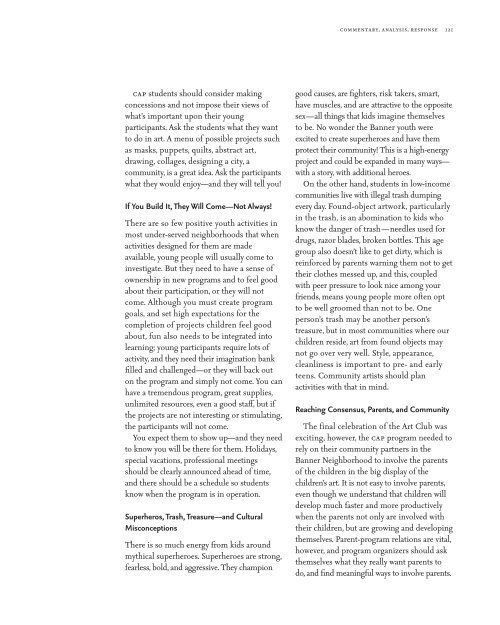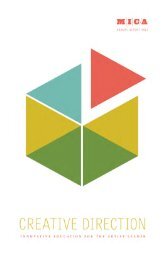art/vision/voice - Maryland Institute College of Art
art/vision/voice - Maryland Institute College of Art
art/vision/voice - Maryland Institute College of Art
You also want an ePaper? Increase the reach of your titles
YUMPU automatically turns print PDFs into web optimized ePapers that Google loves.
cap students should consider making<br />
concessions and not impose their views <strong>of</strong><br />
what’s important upon their young<br />
p<strong>art</strong>icipants. Ask the students what they want<br />
to do in <strong>art</strong>. A menu <strong>of</strong> possible projects such<br />
as masks, puppets, quilts, abstract <strong>art</strong>,<br />
drawing, collages, designing a city, a<br />
community, is a great idea. Ask the p<strong>art</strong>icipants<br />
what they would enjoy—and they will tell you!<br />
If You Build It, They Will Come—Not Always!<br />
There are so few positive youth activities in<br />
most under-served neighborhoods that when<br />
activities designed for them are made<br />
available, young people will usually come to<br />
investigate. But they need to have a sense <strong>of</strong><br />
ownership in new programs and to feel good<br />
about their p<strong>art</strong>icipation, or they will not<br />
come. Although you must create program<br />
goals, and set high expectations for the<br />
completion <strong>of</strong> projects children feel good<br />
about, fun also needs to be integrated into<br />
learning; young p<strong>art</strong>icipants require lots <strong>of</strong><br />
activity, and they need their imagination bank<br />
filled and challenged—or they will back out<br />
on the program and simply not come. You can<br />
have a tremendous program, great supplies,<br />
unlimited resources, even a good staff, but if<br />
the projects are not interesting or stimulating,<br />
the p<strong>art</strong>icipants will not come.<br />
You expect them to show up—and they need<br />
to know you will be there for them. Holidays,<br />
special vacations, pr<strong>of</strong>essional meetings<br />
should be clearly announced ahead <strong>of</strong> time,<br />
and there should be a schedule so students<br />
know when the program is in operation.<br />
Superheros, Trash, Treasure—and Cultural<br />
Misconceptions<br />
There is so much energy from kids around<br />
mythical superheroes. Superheroes are strong,<br />
fearless, bold, and aggressive. They champion<br />
commentary, analysis, response 121<br />
good causes, are fighters, risk takers, sm<strong>art</strong>,<br />
have muscles, and are attractive to the opposite<br />
sex—all things that kids imagine themselves<br />
to be. No wonder the Banner youth were<br />
excited to create superheroes and have them<br />
protect their community! This is a high-energy<br />
project and could be expanded in many ways—<br />
with a story, with additional heroes.<br />
On the other hand, students in low-income<br />
communities live with illegal trash dumping<br />
every day. Found-object <strong>art</strong>work, p<strong>art</strong>icularly<br />
in the trash, is an abomination to kids who<br />
know the danger <strong>of</strong> trash—needles used for<br />
drugs, razor blades, broken bottles. This age<br />
group also doesn’t like to get dirty, which is<br />
reinforced by parents warning them not to get<br />
their clothes messed up, and this, coupled<br />
with peer pressure to look nice among your<br />
friends, means young people more <strong>of</strong>ten opt<br />
to be well groomed than not to be. One<br />
person’s trash may be another person’s<br />
treasure, but in most communities where our<br />
children reside, <strong>art</strong> from found objects may<br />
not go over very well. Style, appearance,<br />
cleanliness is important to pre- and early<br />
teens. Community <strong>art</strong>ists should plan<br />
activities with that in mind.<br />
Reaching Consensus, Parents, and Community<br />
The final celebration <strong>of</strong> the <strong>Art</strong> Club was<br />
exciting, however, the cap program needed to<br />
rely on their community p<strong>art</strong>ners in the<br />
Banner Neighborhood to involve the parents<br />
<strong>of</strong> the children in the big display <strong>of</strong> the<br />
children’s <strong>art</strong>. It is not easy to involve parents,<br />
even though we understand that children will<br />
develop much faster and more productively<br />
when the parents not only are involved with<br />
their children, but are growing and developing<br />
themselves. Parent-program relations are vital,<br />
however, and program organizers should ask<br />
themselves what they really want parents to<br />
do, and find meaningful ways to involve parents.
















